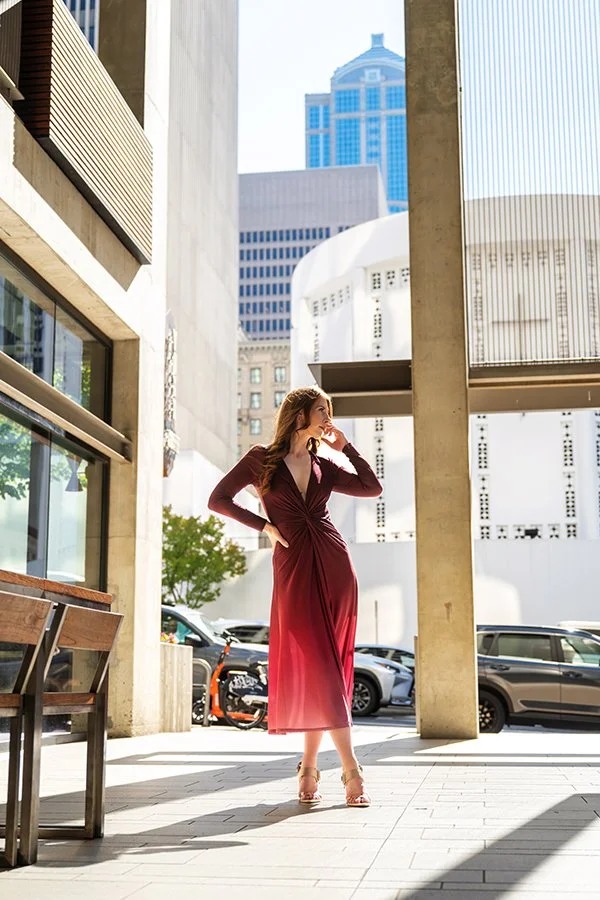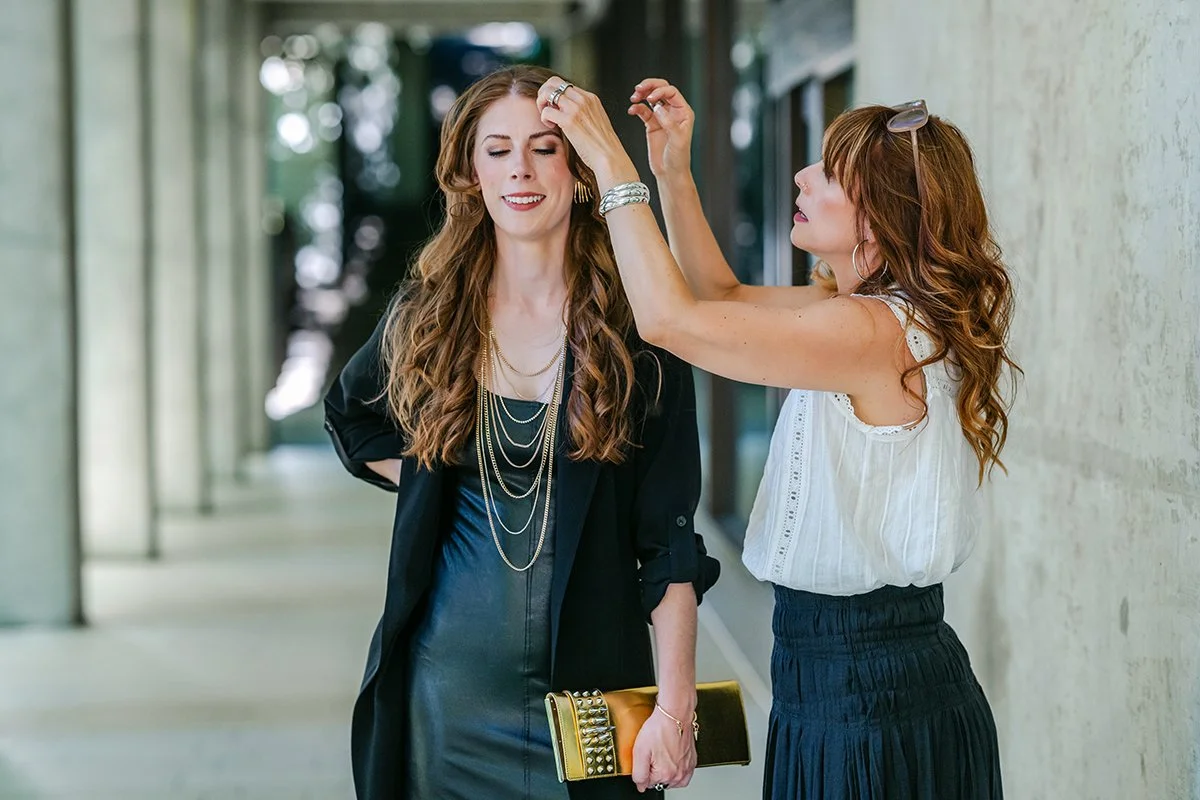The First Step to a Wardrobe That Works: Understanding What Doesn’t
Poplin client Jaysea in pieces ordered exclusively online thanks to her Uber Wishlist.
Part ONE of our three part series on Returns.
As a personal stylist for women, understanding what prevents a woman from harnessing her authentic personal style is a big component of my job. If you’ve been a member of the Poplin Community for a while, you likely know that the Poplin System relies on filters to help each woman have a curated wardrobe that simplifies her life without sacrificing her unique personal style or functionality. Those filters are: personal style key words (words you’d like people to use to describe your style), body type and color palette. Taking it to the next level? You can also throw in budget, values and lifestyle.
Creating a wardrobe that feels like a boutique curated just for you is absolutely possible. You’ll find it saves you time, money, heartache AND is a more sustainable choice.
Let’s say you are already using the Poplin filters to shop and curate your collection but you still have questions. I’ve got you.
We’re kicking off a three part series on Returns. If you’re shopping, you’re returning. The goal is to return less because you’re purchasing the ideal pieces from the get-go. Let’s talk about how to make sure you’re doing that. Go!
Behind the scenes at Jaysea’s Poplin client photo shoot as part of her Amplified 360 Styling Package.
Beyond the Poplin Filters: How to Buy With Intention and Decrease the Number of Pieces You’re Returning
Understand when to invest vs. when save.
When I present to a group or run a workshop, one of the most common questions I hear is, “what should be an investment piece and what should I spend less money on?” There are so many theories about this with many of them focusing on “timelessness” or quality of fabrics like leather. I have a different take and like many things, it’s more nuanced and can be different for some women than others.
Start with whether or not your weight fluctuates. If it does, you’ll want to splurge on items that you adore, meet all your Poplin filters AND are more likely to fit you over time. For example, I have a triangle shaped figure, so my top half is smaller than my bottom half and my weight fluctuation typically happens more on the bottom than the top. So, I invest in leather jackets or dresses that will work if my weight is up or down. Jeans, pants, form fitting skirts? Those are places that I spend less.
Also, think about your style. Are you someone who prefers timelessness or do you love a trend? If so, you may opt to rent or buy either second hand, discount (I’m looking at you, Nordstrom Rack) or both. Investing should be limited to pieces that you know you’ll love for the duration or if you would just rather have quality items, regardless of how long you’ll actually wear them.
Price per wear is another great metric that helps you decide when to spend more or less. But keep in mind that although you may only wear that cocktail dress once and those jeans 100 times, you may only be photographed in the dress. So, think about price per documentation as well as price per wear.
Lastly, consider fit. If it’s challenging for you to find pants that fit, for example. Spend more on one or two stellar pairs that are ideal for your shape. And cut back on items that seem to always fit, like tops.
Don’t be afraid to buy multiple items from one brand to find coordinating pieces, but be thoughtful about quantity.
There was a time when I couldn’t get enough teal for clients. It’s a beautiful neutral that looks good on so many women. It’s unexpected and sophisticated. It was also difficult to find. So, when a brand used the color in a collection, it was a gold mine. Teal, red and salmon are just a few of the colors that come in a zillion hues. If you’ve purchased a red dress only to discover that your red clutch won’t match, you see where I’m going here. Grab those pieces in the same shade when you can as it will make creating coordinating outfits much easier in the future. This is also true for prints. A nice hack for this is to have your color palette available on your phone. This ensures that you only purchase items in the colors in your palette, ensuring that you have the perfect red, for instance, every time.
Don’t compromise on color.
Most clothing can be altered if the fit isn’t right. But the color isn’t going to change. (Sure, you can dye it but will you?) If it isn’t the right color, just accept that it isn’t the right color. I see this often when a woman will stock up on an item and buy every color available then discover that she is wearing a couple choices on repeat and skipping the others. I know it can be hard to find things that fit. But even if it fits, if the color is wrong, walk away.
Shop using your measurements and forget about vanity sizing.
Sizes are just arbitrary. I know, it’s a drag. But, it’s true. Sometimes you can be a six and other times an eight and maybe even a ten. What’s happening? Well, sadly, women’s clothing is not standardized. So forget about the size number and focus on the fit. And remember, if you need to, you can tailor. More on that in a moment.
Importantly, retailers that carry multiple brands may or may not have accurate size charts for those brands. So, put in a little extra time to research sizing for the brand you are purchasing. Some brands have really wonderful tools to help you find your fit. A few of my favorites are Skims, Marcella NYC and Zara.
embrace the tailor.
Every Poplin client has access to our Master Tailor. Tailoring goes well beyond hemming a pair of pants. Even if you aren’t a client, think out of the box when it comes to reinventing your pieces. If there isn’t enough fabric to let out the bust on your dress, consider turning it into a skirt. Or, make it a two piece set by adding fabric in strategic places. Maybe you can just change the neckline and it will lay nicely. After all, a v-neck needs less fabric than a crewneck. If you found something you adore OR you found the best item you think you can and it still doesn’t work quite right. Invest in the tailor and make it perfect for you.
Don’t fight your feelings about fabric.
I used to love a great cut and color with little attention to fabric. Then, almost overnight, I became much less flexible. If you ever feel like you are especially sensitive about the quality of fabric or how soft it is, I hear you. Are you too picky? Who is to say? And you are the only qualified judge on this topic:)
The valuable lesson here is embracing who you are. Style is about authenticity. If you don’t like certain fabrics, acknowledge that and don’t compromise when shopping, especially online. If you aren’t sure what a fabric feels like, a quick search on the exact fabric will give you helpful information. I find Tencel, silk and cotton to be solid wins when shopping online. Faux leather or vegan leather can range from incredible to wildly disappointing. Check the reviews or start with brands you know or trust. Price isn’t necessarily an indicator of how leather-like a fabric is.
Now you’ve got a solid framework to prevent overconsumption of items you’ll never wear. Next up- let’s dive into the criteria for whether or not to return a pair of shoes.
P.S. Did you know that retailers are tracking the volume and frequency of your returns? If you buy a ton, return a ton, and repeat this process on the regular, here’s some helpful info.
Pin This!
Come on In!
Holy crow there are a lot of benefits to being a member of the Poplin community. You’ll receive my Top 100 Favorite Retailers Organized by Personal Style AND the Wildly Popular Six Weeks of Style Tips. Poplin email subscribers also get the newsletter directly to their inboxes every other Friday PLUS all sorts of bonus content that is not published on the blog. Sign up! We won’t spam you or share your info with anyone else. Already on the list? Share Poplin with a friend who’d love this content, too!




